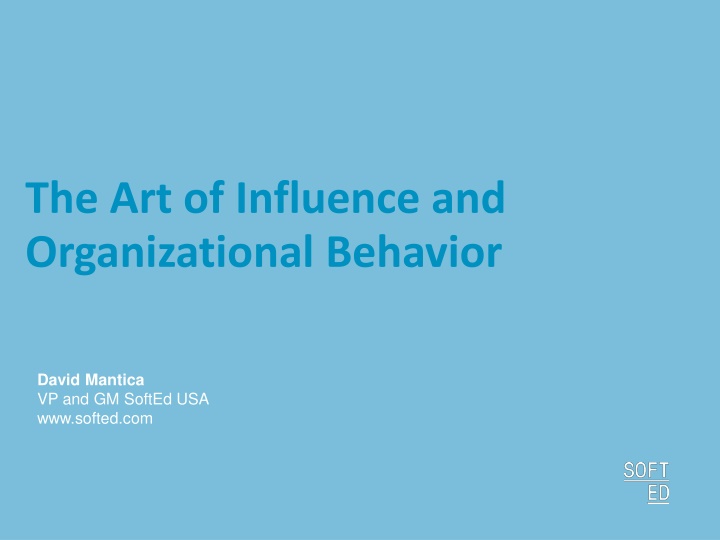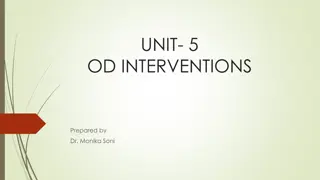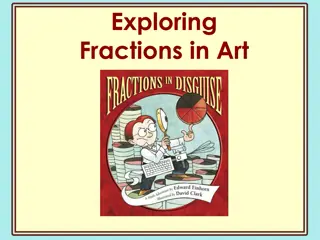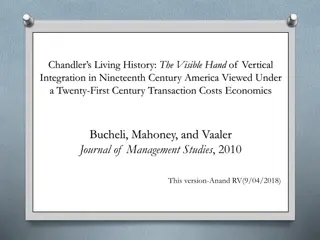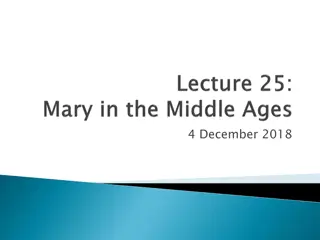The Art of Influence and Building Relationships in Organizations
Explore the power of influence, likeability, and trust in organizational behavior with insights on leveraging these factors to drive success. Learn about the importance of building relationships, communicating effectively, and utilizing tools for influence. Discover the core principles of Likeonomics, trust-building strategies, and key insights into communication for impactful leadership.
Download Presentation

Please find below an Image/Link to download the presentation.
The content on the website is provided AS IS for your information and personal use only. It may not be sold, licensed, or shared on other websites without obtaining consent from the author.If you encounter any issues during the download, it is possible that the publisher has removed the file from their server.
You are allowed to download the files provided on this website for personal or commercial use, subject to the condition that they are used lawfully. All files are the property of their respective owners.
The content on the website is provided AS IS for your information and personal use only. It may not be sold, licensed, or shared on other websites without obtaining consent from the author.
E N D
Presentation Transcript
The Art of Influence and Organizational Behavior David Mantica VP and GM SoftEd USA www.softed.com
Agenda Part 1: Introduction Why we are here Likeability and competency What is Likeonomics Part 2: Distortions that impact influence and likeability Impact of having power Cognitive biases Part 3: Tools for Influence Power base and influence Likeable techniques Influence/likeable tools Influence vs. manipulator
Part 1: Introduction You can t change human nature, but you can know and adapt to it There is one thing you can do is influence people In chat, tell us an example of when you influenced someone
Why is this topic important? Requirements Technology
Evolution of judging a book by its cover: Trust and Competency
Fun and good/jerk yet talented first judgement; competency and trust continued
Likeonomics fundamental truth We all do business and build relationships with people we like. The simple metric of likeability powers everything from who we believe to what we buy, and it is NOT about simply being nice. In chat, tell us about a situation where you tried to build a relationship around being Nice . Did it work or not. If it failed what happened to cause it to fail In chats, what are your thoughts on some of the negative outcomes of working and buy only from people we like.
Likeonomics 101: trust formula Truth Relevance Unselfishness Simplicity Timing
Likeonomics 101: 5 big insights into communications There is a modern believability crisis People make decisions emotionally, not logically Stories are the most compelling form of communication Simplicity is the foundation of all great communication In strangers (micro-expertise) we trust
Part 2: Distortions Our brains are not built for white collar work
Power* is The ability to do or act; the capability of doing or accomplishing something by using command or control over others. * Source: Dictionary.com
Status and the corrupting effects of power 1. Higher share of rewards 2. Commands rather than requests 3. Corrupting influence on groups 4. Abuse of power 5. It is a self-reinforcing cycle 6. Poor decision making 7. Sexual harassment http://bankofinfo.com/impact-of-power-on-others/
More basic look at power corrupting Researchers believe power has a somewhat dehumanizing effect on people and the powerful are more self-focused and less empathetic Powerful people or people who think they are powerful show less motor resonance. Can t imagine things from other perspectives Powerful people don t think they are better they just don t think about others Happens to anyone who feels powerful not just rich or famous How does this tie to influence How does this impact likeability
Cognitive Biases impacting connecting with people Cognitive dissonance The gap between what we believe and information that conflicts with it Brain lights up with confirmation information Brain goes dark with disconfirming information There are different impairments that impact us in different ways Two primary issues Applying cognitive basis without realizing it Relying on habitual mental tools (heuristics) to make decisions Making judgements and reacting to people without full understanding
Endowment Effect An interesting finding in the literature shows that individuals consistently evaluate identical objects as more valuable if they own them.
Loss or regret aversion Loss aversion and framing If the same choice is framed as a loss, rather than as a gain, different decisions will be made. -In Slido, give us some examples of how you may have been impacted by Loss / regret or how others around you have been.
Social proof What s this line for? I don t know, I just saw everyone standing here and figured it must be good!
Confirmation bias In chat, give us some thoughts on how to avoid this. People almost always find what they re expecting to find if they allow their expectations to guide their search. Bart Ehrman
Part 3: Tools To be influential you must understand the dynamics of being liked and believed and you must use tools to connect with people
Six power bases Coercive Expert Information Positional Referent Reward Connecting influence and power base There are power bases suited to drive impactful influence and some that lead to problems
What is influence Denotation: The capacity to have an effect on character, development or behavior of someone or something, or the effect itself (noun) Have an influence on / persuade (verb) Connotation: Getting someone or a group to do something that you believe is right that will help the group, team or organization for the better
Influence buildup Influence Change Management Facilitation and Negotiation Conflict Management Emotional Intelligence
Influence practice #1 Using the referent power base Most effective power base Second least obvious power base Often called charismatic power Uses influencing abilities to attract others by building loyalty based on charisma and interpersonal skills Involves the ability to influence others to identify with the holder s personal qualities
Influence practice #2 Putting people at ease Body language, tone of voice, language used Use these tools to get people comfortable Smile / use positive demeanor Focus on your point of reference Don t cross the door mat line
Influence practice #3 Read people When you do number #1 put people at ease you gain an advantage More comfortable someone is the more information they provide The more information you get Reading someone helps you knock down walls faster and get to the heart of the situation Given our current situation how can you do this? Tell us your thoughts in chat
Influence practice #4 Be transparent Remember the story of the Emperor s Robe http://www.andersen.sdu.dk/vaerk/hersholt/TheEmperorsNewClothes_e.html Leaders seldom get honest feedback Honest and direct, use best practice #1 in how you deliver Use facts and tie back to specific goals Your likeability goes through the roof when you do this right
Influence practice #5 Provide solutions / ideas The goal is to move forward so give direction on how to move forward Don t be a chicken little Give solutions and discuss which solution you would do and why show skin in the game Accept the final decision even if it isn t your choice or suggestion, move to execution Keep your ideas SIMPLE even though there are more details underneath
Influence practice #6 Don t be a manipulator / strategy person Manipulators point out problems, seldom offer solutions and NEVER execute Strategy people, give solutions and ideas but never execute It is all about getting things done. Execution builds trust and proves competence
Coaching and mentoring; the primary tool for likeable people Coaching is influence tied to day to day tactical and strategic work Push Coaching Normal type, just in time, dealing with work improvement does fix problems in short term provides long term improvement. Causes short term conflict Pull coaching Where coaching should be, person comes to you, much more strategic, quicker impact, higher quality work Mentoring is a development relationship; more experienced person helps guide a less experienced one Directive: Transfer of knowledge and wisdom Non-Directive: Helps mentee form their own solution
Resources: Beat the distortions Thinking Fast and Slow https://www.amazon.com/Thinking-Fast-Slow-Daniel-Kahneman/dp/0374533555 Outliers https://www.amazon.com/Outliers-Story-Success-Malcolm-Gladwell/dp/0316017930 David and Goliath https://www.amazon.com/David-Goliath-Underdogs-Misfits-Battling/dp/0316204374 Moneyball https://www.amazon.com/Moneyball-Art-Winning-Unfair- Game/dp/0393324818/ref=sr_1_1?keywords=moneyball&qid=1558987654&s=books&sr=1-1 Monday Morning Leadership https://www.amazon.com/Monday-Morning-Leadership-Mentoring- Sessions/dp/0971942439/ref=sr_1_2?crid=2HF4TJ7ZFQ6Y&keywords=monday+morning+leadership +by+david+cottrell&qid=1558987709&s=books&sprefix=monday+morning+%2Cstripbooks%2C154& sr=1-2
PDU Credit: 1 Leadership PDU Course Identifier: AIOBWeb110620X PDU Claim Code: 4102QVBNFC
Thank you! I appreciate your time. Any questions? Buy One Get One on SoftEd courses David Mantica VP and GM SoftEd USA DavidM@softed.com
